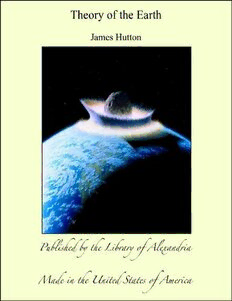
Theory of the Earth; or an investigation of the laws observable in the composition, dissolution, and restoration of land upon the Globe PDF
987 Pages·1788·3.948 MB·English
Most books are stored in the elastic cloud where traffic is expensive. For this reason, we have a limit on daily download.
Preview Theory of the Earth; or an investigation of the laws observable in the composition, dissolution, and restoration of land upon the Globe
Description:
James Hutton was an 18th century Scottish geologist, physician, chemist and naturalist. He originated the theory of uniformitarianism — a fundamental principle of geology — that explains the features of the Earth's crust by means of natural processes over geologic time. Hutton's work established geology as a science, and as a result he is often referred to as the “Father of Modern Geology”. From the American Museum of Natural History: “Hutton came to believe that the Earth was perpetually being formed; for example, molten material is forced up into mountains, eroded, and then eroded sediments are washed away. He recognized that the history of the Earth could be determined by understanding how processes such as erosion and sedimentation work in the present day. His ideas and approach to studying the Earth established geology as a proper science. In the late eighteenth century, when Hutton was carefully examining the rocks, it was generally believed that Earth had come into creation only around six thousand years earlier (on October 22, 4004 B.C., to be precise, according to the seventeenth century scholarly analysis of the Bible by Archbishop James Ussher of Ireland), and that fossils were the remains of animals that had perished during the Biblical flood. As for the structure of the Earth, “natural philosophers” agreed that much bedrock consisted of long, parallel layers which occurred at various angles, and that sediments deposited by water were compressed to form stone. Hutton perceived that this sedimentation takes place so slowly that even the oldest rocks are made up of, in his words, “materials furnished from the ruins of former continents.” The reverse process occurs when rock exposed to the atmosphere erodes and decays. He called this coupling of destruction and renewal the “great geological cycle,” and realized that it had been completed innumerable times.” In the famous last sentence of his book, Hutton states: “The result, therefore, of this physical enquiry, is that we find no vestige of a beginning, no prospect of an end.”(This file includes Volumes 1 and 2.)
See more
The list of books you might like
Most books are stored in the elastic cloud where traffic is expensive. For this reason, we have a limit on daily download.
